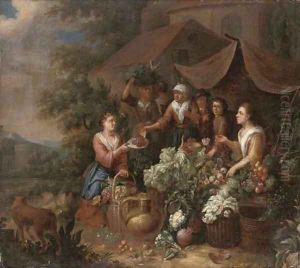An Pauwel II The Younger Gillemans Paintings
An Pauwel II The Younger Gillemans was a Flemish painter, born in 1618 in Antwerp, a city renowned for its vibrant artistic community during the 17th century. He was part of a family deeply entrenched in the arts, with his father, Jan Pauwel Gillemans the Elder, also being a respected painter. This familial background provided An Pauwel with a rich artistic education and environment from a young age, setting the stage for his future career in the world of art. His work primarily focused on still life, a genre that was gaining significant popularity in Europe at the time, especially within Flemish and Dutch artistic circles.
Gillemans' paintings are characterized by their meticulous attention to detail, rich color palettes, and the ability to capture the texture and materiality of the objects he depicted. His still lifes typically featured arrangements of fruits, flowers, and sometimes game or musical instruments, arranged against a dark background to enhance their vibrancy and the illusion of depth. This technique was a hallmark of the Flemish still life genre, and Gillemans was adept at employing it to create compositions that were both realistic and imbued with a sense of opulence and abundance.
Throughout his career, An Pauwel II The Younger Gillemans contributed significantly to the development of the still life genre in Flanders. His work not only reflects the artistic traditions of his time but also showcases his personal innovation within these conventions. Despite the high quality of his paintings, Gillemans did not achieve the same level of fame as some of his contemporaries, such as Jan Davidsz. de Heem or Daniel Seghers. However, his contributions to Flemish art have been increasingly recognized and appreciated in more recent times, with art historians and collectors giving his work the attention it merits.
Gillemans' influence extended beyond his immediate circle, inspiring the next generation of still life painters in Flanders and beyond. His legacy is preserved in the collections of various museums and galleries, where his paintings continue to be studied and admired for their beauty and technical skill. An Pauwel II The Younger Gillemans passed away in 1675 in Antwerp, leaving behind a body of work that remains a testament to his skill and dedication to the art of painting.
